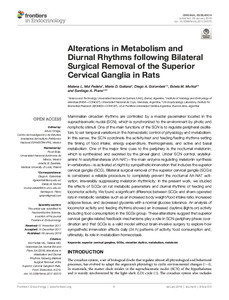Por favor, use este identificador para citar o enlazar este ítem:
https://repositorio.uca.edu.ar/handle/123456789/1466| Título: | Alterations in metabolism and diurnal rhythms following bilateral surgical removal of the superior cervical ganglia in rats | Autor: | Mul Fedele, Malena L. Galiana, María D. Golombek, Diego A. Muñoz, Estela M. Plano, Santiago Andrés |
Palabras clave: | MELATONINA; RITMO CIRCADIANO; METABOLISMO; HOMEOSTASIS; FISIOLOGIA; ENDOCRINOLOGIA | Fecha de publicación: | 2018 | Editorial: | Frontiers Media | Cita: | Mul Fedele, M. L., et al. Alterations in metabolism and diurnal rhythms following bilateral surgical removal of the superior cervical ganglia in rats [en línea]. Frontiers in Endocrinology. 2018, 8. doi:10.3389/fendo.2017.00370. Disponible en: https://repositorio.uca.edu.ar/handle/123456789/1466 | Resumen: | Abstract: Mammalian circadian rhythms are controlled by a master pacemaker located in the suprachiasmatic nuclei (SCN), which is synchronized to the environment by photic and nonphotic stimuli. One of the main functions of the SCN is to regulate peripheral oscillators to set temporal variations in the homeostatic control of physiology and metabolism. In this sense, the SCN coordinate the activity/rest and feeding/fasting rhythms setting the timing of food intake, energy expenditure, thermogenesis, and active and basal metabolism. One of the major time cues to the periphery is the nocturnal melatonin, which is synthesized and secreted by the pineal gland. Under SCN control, arylalkylamine N-acetyltransferase (AA-NAT)—the main enzyme regulating melatonin synthesis in vertebrates—is activated at night by sympathetic innervation that includes the superior cervical ganglia (SCG). Bilateral surgical removal of the superior cervical ganglia (SCGx) is considered a reliable procedure to completely prevent the nocturnal AA-NAT activation, irreversibly suppressing melatonin rhythmicity. In the present work, we studied the effects of SCGx on rat metabolic parameters and diurnal rhythms of feeding and locomotor activity. We found a significant difference between SCGx and sham-operated rats in metabolic variables such as an increased body weight/food intake ratio, increased adipose tissue, and decreased glycemia with a normal glucose tolerance. An analysis of locomotor activity and feeding rhythms showed an increased daytime (lights on) activity (including food consumption) in the SCGx group. These alterations suggest that superior cervical ganglia-related feedback mechanisms play a role in SCN-periphery phase coordination and that SCGx is a valid model without brain-invasive surgery to explore how sympathetic innervation affects daily (24 h) patterns of activity, food consumption and, ultimately, its role in metabolism homeostasis. | URI: | https://repositorio.uca.edu.ar/handle/123456789/1466 | ISSN: | 1664-2392 | Disciplina: | MEDICINA | DOI: | 10.3389/fendo.2017.00370 | Derechos: | Acceso Abierto | Fuente: | Frontiers in Endocrinology. 2018, 8. |
| Aparece en las colecciones: | Artículos |
Ficheros en este ítem:
| Fichero | Descripción | Tamaño | Formato | |
|---|---|---|---|---|
| alterations-metabolism-diurnal-rythms.pdf | 2,07 MB | Adobe PDF |  Visualizar/Abrir |
Visualizaciones de página(s)
187
comprobado en 30-abr-2024
Descarga(s)
157
comprobado en 30-abr-2024
Google ScholarTM
Ver en Google Scholar
Altmetric
Altmetric
Este ítem está sujeto a una Licencia Creative Commons

